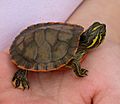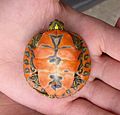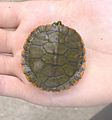Alabama red-bellied cooter facts for kids
Quick facts for kids Alabama red-bellied cooter |
|
|---|---|
 |
|
| Conservation status | |
| Scientific classification | |
| Genus: |
Pseudemys
|
| Species: |
alabamensis
|
 |
|
| Alabama red-bellied cooter range | |
| Synonyms | |
|
|
The Alabama red-bellied cooter (Pseudemys alabamensis), also known as the Alabama red-bellied turtle, is a special turtle found only in Alabama. It's part of the Emydidae family, which are often called pond turtles. This unique turtle is even the official state reptile of Alabama!
Contents
What is the Alabama Red-Bellied Cooter Like?
These turtles love living in water that is fresh or a little bit salty. You can find them in the Mobile–Tensaw River Delta in Mobile and Baldwin counties. They enjoy eating plants that grow in the water. Sometimes, you might see them relaxing and warming up in the sun on logs.
How Do They Nest?
Female red-bellied turtles lay their eggs from May to July. They dig nests in sandy soil on dry land. Each nest usually holds about 4 to 9 eggs. Baby turtles, called hatchlings, often come out of their eggs in the summer. If the eggs are laid later in July, the hatchlings might stay in the nest all winter and come out the next spring.
How Big Do They Get?
Adult female turtles can grow up to 14 inches long. Males are a bit smaller, reaching about 12 inches in length.
Where Do Alabama Red-Bellied Cooters Live?
Most of these turtles live in the Mobile–Tensaw River Delta in Alabama. As of 2009, some have also been seen in Elmore County, which is in central Alabama. You might also find them in parts of southeastern Mississippi, specifically in Harrison and Jackson counties.
How Are They Protected?
The Alabama red-bellied cooter is an endangered species, which means it needs protection. In 2007, a long fence was built along part of the US 98 causeway, also known as Battleship Parkway. This fence helps separate the Mobile-Tensaw delta from Mobile Bay. After the fence was built, the number of baby turtles dying dropped by 80% between 2007 and 2008. This shows how important it is to protect these special turtles.
Gallery
See also
 In Spanish: Tortuga de vientre rojo de Alabama para niños
In Spanish: Tortuga de vientre rojo de Alabama para niños





